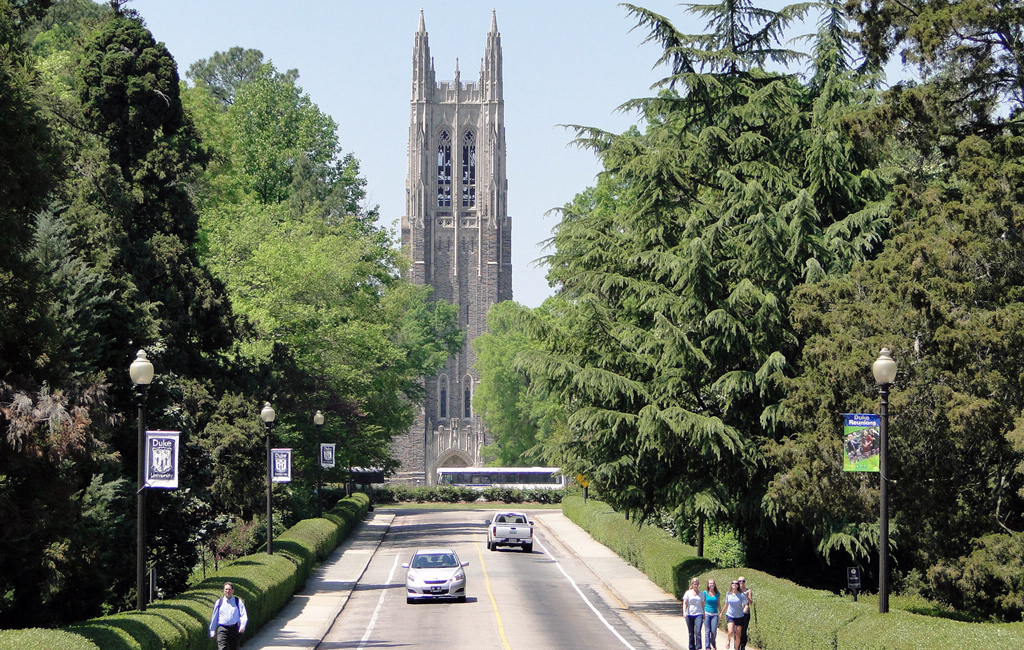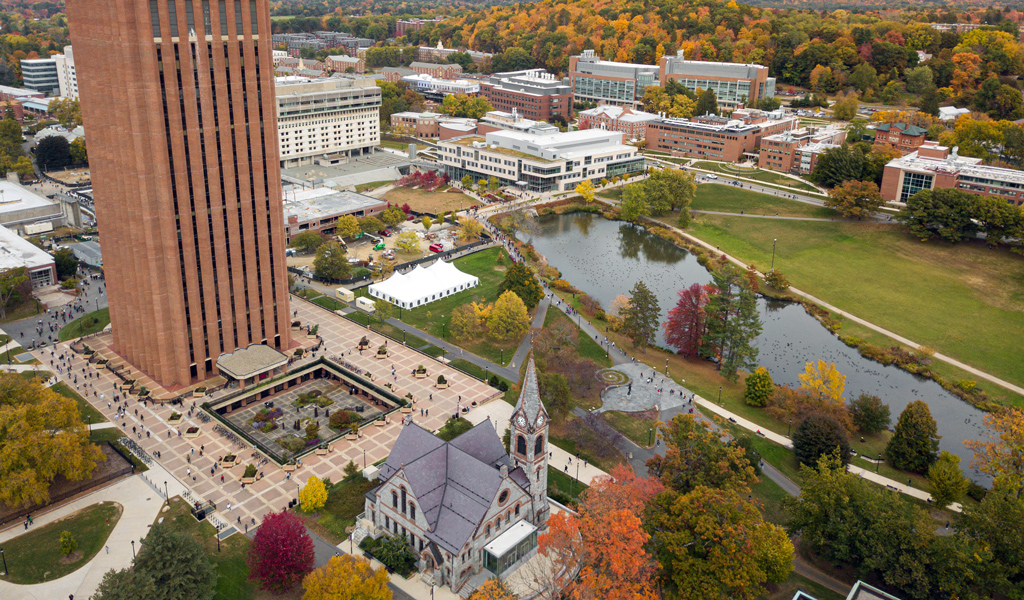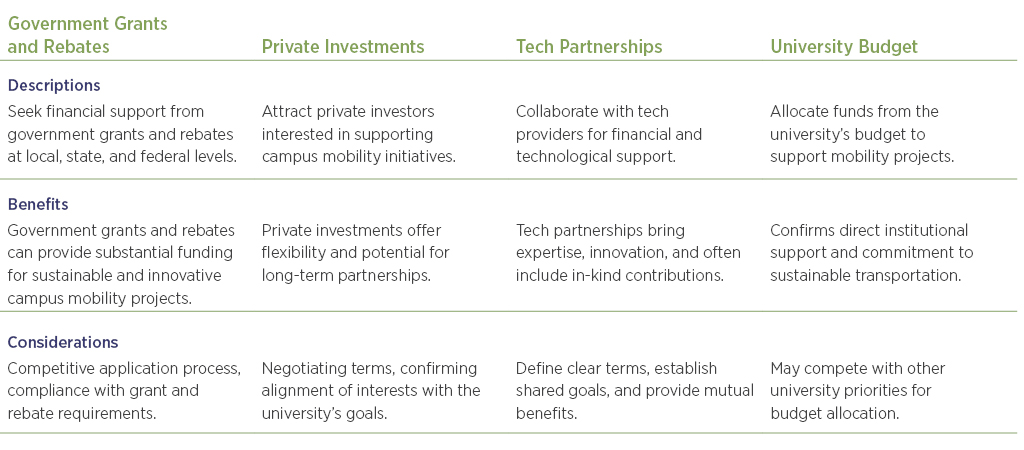Forward-thinking insights focused on a more sustainable tomorrow.
Future-Proofing Campus Mobility: Embracing Tech for Tomorrow
Overcoming mobility challenges with innovative, sustainable transportation solutions.
Efficient campus mobility is the cornerstone of academic institutions. It not only enhances accessibility but also contributes to sustainability and the overall well-being of students and staff. In an era marked by rapid urbanization, environmental concerns, and evolving student needs, campus mobility faces an array of intricate challenges and promising opportunities. Much like the global energy evolution toward clean and renewable sources, campuses are experiencing a shift in their approach to transportation, characterized by the transition to electric vehicles (EVs), a decline in bus ridership, the rise of micromobility, and more.
Amid these changes, one constant remains: the critical role of technology. Leveraging advanced tools and digital solutions—like digital twins, model-based design, and data-driven insights—from the planning phase can help campuses navigate these challenges while future-proofing their mobility strategies. Future-proofing campus mobility is essential to make certain that colleges and universities adapt to changing transportation trends, reduce environmental impact, and meet the evolving needs of their campus communities long-term.
Unraveling Campus Mobility Challenges
College campuses serve as vibrant hubs of intellectual exchange and personal growth, fostering a diverse community of students, faculty, and staff. However, this dynamic environment also presents a unique set of mobility challenges that hinder seamless movement and efficient resource utilization. Understanding these challenges is crucial for devising effective solutions that future-proof campus mobility.
Changing travel patterns
The COVID-19 pandemic dramatically altered campus commute patterns. While some institutions have witnessed a return to pre-pandemic usage, others have seen a surge in hybrid or fully remote employees, disrupting previously predictable travel and parking revenue streams. Formerly, annual parking permits were a reliable source of income; now, many commuters forgo these in favor of more flexible arrangements. This shift has increased the demand for real-time transportation management and introduced greater revenue variability for campuses with paid parking facilities.
Data and asset management
Administrators increasingly seek data to drive better-informed decisions, particularly amid rising costs and fluctuating revenues. Comprehensive data on facility usage—including user frequency and duration—has become pivotal. Additionally, universities not only have to maintain aging, and often expensive, parking assets but also adapt to new challenges like integrating EV charging stations, which may involve upgrading electrical panels and implementing new technology solutions for station management. Leveraging current data and strategic planning for new data streams are essential to the long-term health of the modern campus transportation department.
Affordability
For commuters, transportation costs can account for nearly a fifth of college expenses, presenting a significant financial burden. This financial strain can hinder their academic success and overall campus experience. To mitigate this, some universities have capped transportation and parking fees. However, this, in turn, often leads to budget cuts in the face of escalating costs. In response, several institutions are working to combat the rising commuting cost by substantially increasing their housing portfolio.
Sustainability
While colleges are increasingly committed to reducing their environmental footprint and achieving sustainability goals, motor vehicles are a leading source of air pollutants that affect human health, and the transportation sector generates the largest share of greenhouse gas emissions. As such, universities are under increasing pressure to address these environmental concerns while enhancing campus mobility. Additionally, as sales of EVs grow, campuses face the challenge of providing accessible, highly functional, and sufficient charging for commuters, residents, and fleet vehicles. This shift requires strategic planning to integrate sufficient charging solutions and reduce overall environmental impact while improving campus mobility.
Accessibility
Making certain that all campus community members—regardless of their physical abilities—can navigate campus seamlessly is paramount. This includes providing accessible routes for pedestrians and cyclists, confirming all buildings and facilities are accessible to individuals with disabilities, and offering alternative transportation options for those unable to drive. Overcoming these accessibility barriers requires thoughtful planning and resources, but it is essential for creating an inclusive and functional campus environment.
Harnessing Technology for Mobility Solutions
Addressing these challenges requires a comprehensive approach, leveraging advanced technologies to redefine campus transportation and foster a more sustainable, accessible, and efficient experience. By embracing emerging technologies, institutions can overcome existing limitations and pave the way for a future-proof campus mobility system.
Technology-enabled Transportation
The emergence and broader adoption of EVs stand out as transformative, offering both cost savings and a substantial reduction in greenhouse gas emissions. Integrating EV fleets into sustainable campus transportation initiatives aligns with broader environmental goals, and an increasing number of universities are incorporating EVs into their climate action plans as part of their commitment to achieving overall carbon neutrality.

As part of Duke University’s Climate Action Plan and commitment to a carbon-neutral institution, the University partnered with VHB to develop a Sustainable EV Fleet Infrastructure Plan to reduce campus vehicle emissions.
In addition to EVs, integrating diverse transportation modes, such as active transportation, e-mobility, and microtransit, fosters a healthier and more sustainable campus environment. E-mobility solutions, including shared
e-scooters and e-bikes—while at times controversial—offer a cost-effective and convenient option for short-distance travel. Their growing presence on campuses has reduced reliance on personal vehicles, alleviating parking demands and reducing greenhouse gas emissions. However, successfully incorporating these options hinges on addressing safety concerns and minimizing the risks of collisions between pedestrians, scooters, and vehicles. Additionally, efficiently managing the operations and storage of these mobility devices is essential to confirming they complement rather than complicate the campus transit framework.
Users increasingly demand highly accurate real-time location and arrival information for transit and shuttles serving universities. Students and staff, eager to optimize their schedules and avoid inclement weather, expect seamless shuttle services that offer timely arrivals and departures directly outside their buildings. Modern technology such as passenger counters now provides real-time occupancy information, empowering riders to make informed decisions about travel times to confirm vehicle availability.
Many universities are also adopting nighttime services that mirror microtransit systems, characterized by flexible, demand-responsive transit operations. These services typically utilize smaller vehicles like vans or shuttles and leverage technology to enhance efficiency and user experience. Features include mobile apps for easy ride booking and vehicle tracking, demand-responsive technology to dynamically adapt routes and schedules, and data analytics to refine service based on user behavior patterns. In some instances, if shuttle wait times exceed a predetermined threshold, the system may automatically offer alternatives like rideshares (e.g., Uber or Lyft) to maintain service efficiency and user satisfaction.
Advanced Technology-enabled Solutions
Beyond specific transportation modes, the broader integration of smart mobility technologies is crucial in enhancing the overall campus mobility experience. These technologies range from connected devices through the Internet of Things (IoT) to mobile applications and predictive analytics, all of which contribute to real-time data collection and efficient fleet management.
- Connected devices with IoT allow for seamless communication within the transportation ecosystem, from vehicles and traffic signals to pedestrian crosswalks. This interconnectedness can lead to improved traffic flow, reduced congestion, and enhanced safety.
- Data dashboards allow system managers to understand, in real-time, how the system is functioning and adjust operations if needed. This can include shuttle usage, parking lot occupancy, or reservations for paratransit or other ADA services. Dashboards can also improve asset management, highlighting system alerts or even tracking the progress of maintenance activities.
- Mobile applications can provide users with real-time information about transportation options, schedules, and routes, making it easier to plan journeys. Certain apps can also provide real-time data on parking availability, guide drivers to vacant spots, and even reserve a space in advance—enhancing parking efficiency, minimizing time spent searching for spots, and overall improving customer satisfaction.
- Predictive analytics leverage historical and real-time data to forecast future transportation patterns and needs. This can help in proactive planning and decision-making, allowing for adjustments in routes, schedules, and fleet deployment to better meet demand. Effectively leveraging predictive analytics begins with confirming data is readily available and actionable. If data is confined to static reports or formats that staff find difficult to manipulate or export, it cannot be fully utilized to predict future needs.
- Virtual Design and Construction (VDC) and model-based designs utilize three-dimensional models to simplify both the design and construction phases, helping prevent potential issues and speed up project completion. This approach often includes scanning the site in 3D to create a detailed model of the existing environment. For VDC to be effective, it’s important to set clear project turnover standards. These standards confirm the delivery of 3D models that meet predefined specifications, enabling property owners to manage and maintain their assets efficiently. Utilizing VDC and model-based design is also a key first step toward creating Digital Twins.
- Digital twins are virtual replicas of the physical campus transportation systems. They enable predictive analytics to perform proactive maintenance to better meet operational efficiency goals. By simulating different scenarios and analyzing their potential impacts, digital twins can help identify potential issues before they occur and make informed decisions about system upgrades or modifications.
These advanced technologies power campus mobility management systems, significantly improving the transportation experience. Looking ahead, real-time tracking and demand-responsive systems, driven by AI technologies, can reduce delays, improve rider satisfaction, and increase operational efficiency. By accurately predicting demand and dynamically adjusting service provision, these systems can make certain that transportation resources are utilized effectively and efficiently, leading to cost savings and improved service quality. The first step in this journey is enhanced data and analytics to understand where the system will most benefit from improved use of technology.
The Path to Future-proofing
The Importance of Planning
Planning is a crucial component in future-proofing campus mobility. Universities must strike a balance between implementing short-term solutions to address immediate needs and developing long-term strategies that focus on the evolution of campus mobility over time. The importance of leveraging technology in the planning phase cannot be overstated, as it empowers universities to make data-informed decisions, optimize resources, and create sustainable, future-proof campus mobility solutions.

The University of Massachusetts Amherst (UMass Amherst) partnered with VHB to develop an EV charging plan to address anticipated future demand. The comprehensive planning process involved inventory, data collection, and assessment of UMass Amherst's existing publicly available EV charging facilities and their supporting electrical infrastructure. VHB is now undertaking an in-depth analysis of current charging demand patterns, pinpointing locations with unused conduit rough-ins, and mapping out the distribution of electrical capacity for additional charging spaces.
Collaboration and Partnerships
Collaboration and partnerships are key to leveraging resources effectively. By pooling the knowledge and experience of public transit agencies, tech providers, and local communities, universities can create more effective and sustainable mobility solutions. Increasingly, this includes cross-functional area collaboration, such as installing solar canopies on top of surface lots. Whether developed internally or through third-party partnerships, these integrations not only advance sustainability but also enhance energy resilience. When coupled with battery energy storage systems, such initiatives can further optimize energy consumption and substantially reduce peak demand charges, leading to a greener, more cost-efficient campus transportation network.
Regulatory and Policy Considerations
Successfully navigating regulatory landscapes is crucial to future-proofing campus mobility. Confirming compliance not only mitigates legal risks but also fosters an environment that is conducive to innovation. Universities must stay abreast of the latest regulations and standards related to transportation and mobility, including those specific to EV charging stations. This includes understanding and adhering to local, state, and federal regulations, as well as industry-specific standards.
Funding Strategies
Securing adequate funding is another critical aspect of implementing and sustaining advanced campus mobility solutions. Universities must explore various funding sources, including government grants, private investments, and partnerships with tech providers, while also considering the long-term operational costs of these solutions.

Navigating the grant funding process, however, can be complex and competitive. Partners like VHB can provide comprehensive assistance in this process, from identifying qualifying projects for state or federal grants to providing grant writing support and guiding project planning, design, and construction.
The process of future-proofing campus mobility involves careful planning, strategic collaborations, regulatory compliance, and secure funding. By considering all these aspects, universities can create a sustainable, efficient, and safe campus mobility infrastructure that meets the evolving needs of their communities.
How VHB Can Help
Navigating the rapidly evolving campus mobility landscape can be complex and challenging. Making certain that transportation systems are not only efficient and sustainable today, but also prepared for the demands of tomorrow, requires a deep understanding of existing challenges, emerging technologies, and long-term trends. At VHB, we combine our technical skills and experience with a forward-thinking approach to help universities future-proof their campus mobility solutions.
We understand that each institution is unique, with its own set of mobility challenges and opportunities. Our integrated approach is tailored, responsive, and holistic, accounting for all aspects of campus mobility—from infrastructure and technology to sustainability and user experience.
We work closely with universities to monitor, evaluate, and optimize their mobility solutions, making certain they continue to meet changing demands and take advantage of new opportunities.
Connect with National Practice Leader for Campus Mobility, Nat Grier, or Regional Technology-enabled Lead, Michael Parkin, to start designing a resilient, efficient, and future-ready campus today.




